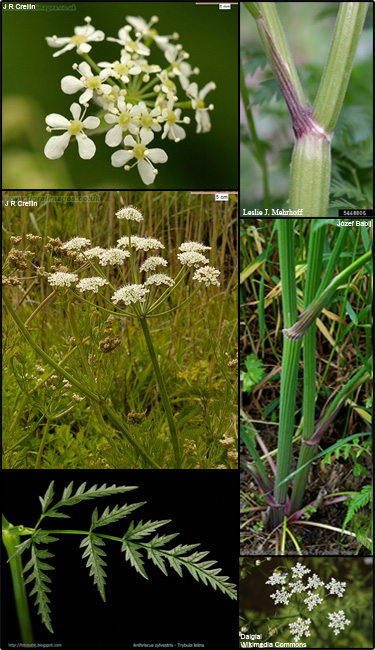Wild chervil (Anthriscus sylvestris)
 Common Names: False chervil
Common Names: False chervilDescription: This plant is edible. It is also considered to be a natural mosquito repellent.
Habit: Biennial; grows 3-4 ft but can grow up to 6 ft; tuberous roots are aggressive and spread rapidly.
Leaves: Fern-like, nearly hairless (some hairs on lower surface), divided into smaller leaflets which in turn are also divided, leaf bases surround stem, can grow over 1 ft long.
Stems: Hollow and furrowed; soft-hairy below, smooth above; fringe of hairs at stem nodes.
Flowers: White in color, 5 petals, produced in umbels (umbrella-like cluster) at end of stems, produces 2 joined seeds with small antenna-like structures at the top; blooms May through June.
Fruit and seeds: About 1/4 inch long, at first green, then shiny dark brown at maturity.
Habitat: Native to Europe. Found in woods, roadsides, prairies, hayfields, pastures, waste places, and disturbed areas.
Reproduction: By seed and lateral budding at top of roots.
Similar species: Fool's parsley (Aethusa cynapium); Poison hemlock (Conium maculatum); Eastern hemlockparsley (Conioselinum chinense); Queen Anne's lace (Daucus carota); Caraway (Carum carvi).
Monitoring and rapid response: Hand-pulling, cut at or below soil level, mowing; effectively controlled using any of several readily available general use herbicides such as clopyralid and dicamba. Credits: The information provided in this factsheet was gathered from the USDA PLANTS Database and the U.S. Department of Agriculture, Forest Service.
Individual species images that appear with a number in a black box are courtesy of the Bugwood.org network (http://www.invasive.org).Individual photo author credits may not be included due to the small display size of the images and subsequent difficulty of reading the provided text. All other images appear courtesy of Google (http://images.google.com).
